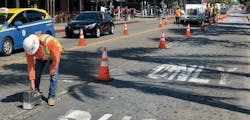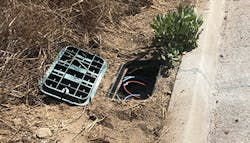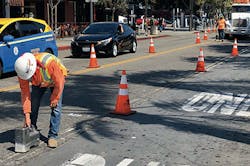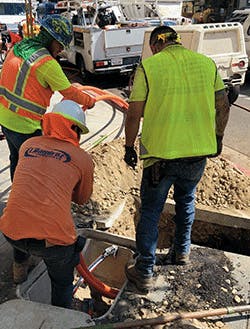Dig Once Best Practices Pay Off
The COVID-19 pandemic has helped spotlight the need for speeding broadband deployment to rural and other unserved areas. And now that the Bipartisan Infrastructure Law has passed, it includes $65 billion for broadband buildouts to bring broadband to those in need.
Department of Transportation Secretary Pete Buttigieg hopes that Dig Once legislation will facilitate that. The Dig Once Act would require that conduit for fiber optic cable be included in the construction of any road being built with federal funds in areas without broadband. The intent of the bill is to accelerate the deployment of broadband (and reduce its cost) by minimizing the number and scale of repeated excavations for the installation and maintenance of broadband conduit or broadband infrastructure in rights-of-way.
Politics aside, this idea of digging once reaches much farther than roads. Some municipalities have adopted a policy of installing fiber duct anytime they do underground construction. If there is construction required for water, sewers, gas, electricity or anything else, they will install some fiber ducts for future use. It’s cheap insurance.
Dig Once solves problems for the future, but what about today? What are the alternatives to underground trenching? Of course, there are aerial cables, but they’re becoming less common in urban areas for aesthetic reasons.
Underground Fiber Installation Techniques
Following are descriptions of 2 sound underground fiber installation techniques.
Technique #1: DIRECTIONAL BORING
This technique does a good job of installing cables without disruption if used properly. But when something goes wrong, it often creates a big problem.
In fact, we regularly hear about contractors boring into gas lines, often with tragic consequences. Last year, that very thing happened near where I live. The puncture occurred in a 16-inch-high pressure gas line. Thankfully, the gas and electrical service was quickly shut off before fires or explosions resulted. This is not unique. One fiber contractor in Nashville managed to puncture 7 water mains in 1 year—flooding neighborhoods and causing substantive damages.
An expert in damage prevention recently told me that damage from directional boring can go unnoticed at the time of installation. Sewer lines are often the victims because they are not well-marked in underground utility maps.
Unfortunately, the damage occurs when the boring tool punches through the sewer pipe. The contractor then goes ahead and installs ducts or other pipes with no signs of damage to the sewer. Later, when a backup in the sewer occurs, the cleaning process may cut the cable or pipe that actually caused the sewer pipe blockage.
Situations like this illustrate the importance for contractors doing directional boring to be extremely careful. They should start by contacting Call Before You Dig and the appropriate local authorities. They should also secure maps of the buried utilities, and use underground locating equipment to double-check the locations where the boring is being done.
Technique #2: MICROTRENCHING
This may be the best development in construction to minimize disruption.
The field team saws a groove in a roadway or sidewalk, installs a small plastic microduct, and blows fiber optic microcable into the duct. The whole process is built around fiber optic microcables that reduce the diameter of a 144-fiber cable to the size of a pencil.
That microcable is then blown into a plastic duct less than a half-inch in diameter. This process floats the cable via high-speed air flow in the duct to reduce friction, and enables the cable to be pushed down the duct for distances of a mile or more.
Microtrenching can be done so neatly that it becomes almost invisible in the street.
Figure 1 shows this type of fiber installation in Southern California. You can see the groove cut along the edge of the pavement and the curb. The microduct with 6 ducts is placed in the groove. Then, the groove is backfilled with a special filler that closely matches the color of the pavement. In this case, one 288-count-fiber cable was blown in one of the ducts. Future projects could add 5 more microcables to the empty ducts for a total of 1,728 fibers to be turned up when needed.
Smart contractors do the right things each time they are installing fiber. A time ago we witnessed an installation in downtown Santa Monica where a tech followed the boring tool down the street with a locator to ensure that it stayed on the proper path. (See Figure 2.) That’s an example others should follow.
Microtrenching is not only for urban areas. Figure 3 shows a contractor who installed hundreds of miles of fiber optic cables using this strategy in rural British Columbia. Aerial cable was not possible due to the area’s harsh winter weather, so an underground cable was required.
Rather than trenching alongside the road, the contractor convinced the customer that microtrenching was better, and he proved it. The installation went much faster and cost much less than conventional trenching.
Underground Installation Alternatives?
Other techniques like using robots to install cables in sewers or removing the insides of CATV coax cable and blowing in fiber optics have been proposed and trialed. But none have gained traction, and some have proven useless.
The worst idea (in our opinion) was called nanotrenching. This technique cut a shallow groove in the roadway, and a fiber optic cable was laid in the groove. It was then covered by rubber cement. Unofficial reports shared how the cable was ripped out in just a few days from the traffic driving over it.
Best Training = Least Disruption
In order to minimize the disruption from construction, municipalities need to understand fiber optic construction practices. Cities like Santa Monica, which started its own fiber network 20 years ago, have staff members who are trained in fiber installation practices and believe in the idea of digging once. That best practice is worth the investment.
You see, Santa Monica figured out long ago that having their own high-fiber-count cables allowed them to become a commercial ISP and lease dark fiber. That generated revenue for the city, and offset the costs of building and operating their own network.
Now, when a contractor does a project in the city, it may include installing multiple fiber ducts for both current and future projects. (See Figure 4).
Remember, training is not frivolous. When service providers hire contractors to install fiber, those contracted engineers and field techs should be trained on which fiber installation techniques suit specific applications.
Unfortunately, contractors complain about the cost of training, or the equipment needed for processes like microtrenching and blowing in microcables. That’s extremely short-sighted, because being able to bid these new techniques gives them a big competitive advantage—especially if they promote their services as "construction without disruption."
For more information, email [email protected], visit https://foa.org/ and follow on Facebook and LinkedIn.
About the Author
Jim Hayes
Fiber Optic Expert
Jim Hayes is the Fiber Optic Expert columnist for ISE Magazine. He is a lifelong techie who has been involved in the fiber optic industry since the late 1970s. He founded one of the world's first fiber optic test equipment companies, FOTEC, which was acquired by Fluke in 2000, and he was a co-founder of the Fiber Optic Association (FOA), the international professional society of fiber optics, in 1995.
Jim is a writer and trainer and the President of FOA. He is the author of nine books on fiber optics and cabling and writes for several magazines.
Jim and his wife, Karen, who is the GM of the FOA, have traveled the world for the FOA helping set up schools to train the workers who design, build, and operate today's communications networks. The FOA offers nearly 1,000 pages of online technical materials, over 100 videos, and two dozen free self-study courses online.
For more information, email [email protected] or visit www.jimhayes.com.
To learn more about The Fiber Optic Association, visit www.thefoa.org. Follow them on Facebook: FiberOpticAssociation, LinkedIn: company/the-fiber-optic-association-inc-foa, and YouTube: user/thefoainc.





